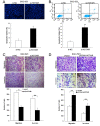Lnc RNA HOTAIR functions as a competing endogenous RNA to regulate HER2 expression by sponging miR-331-3p in gastric cancer
- PMID: 24775712
- PMCID: PMC4021402
- DOI: 10.1186/1476-4598-13-92
Lnc RNA HOTAIR functions as a competing endogenous RNA to regulate HER2 expression by sponging miR-331-3p in gastric cancer
Abstract
Background: Accumulating evidence indicates that the long non-coding RNA HOTAIR plays a critical role in cancer progression and metastasis. However, the overall biological role and clinical significance of HOTAIR in gastric carcinogenesis remains largely unknown.
Methods: HOTAIR expression was measured in 78 paired cancerous and noncancerous tissue samples by real-time PCR. The effects of HOTAIR on gastric cancer cells were studied by overexpression and RNA interference approaches in vitro and in vivo. Insights of the mechanism of competitive endogenous RNAs (ceRNAs) were gained from bioinformatic analysis, luciferase assays and RNA binding protein immunoprecipitation (RIP). The positive HOTAIR/HER2 interaction was identified and verified by immunohistochemistry assay and bivariate correlation analysis.
Results: HOTAIR upregulation was associated with larger tumor size, advanced pathological stage and extensive metastasis, and also correlated with shorter overall survival of gastric cancer patients. Furthermore, HOTAIR overexpression promoted the proliferation, migration and invasion of gastric carcinoma cells, while HOTAIR depletion inhibited both cell invasion and cell viability, and induced growth arrest in vitro and in vivo. In particular, HOTAIR may act as a ceRNA, effectively becoming a sink for miR-331-3p, thereby modulating the derepression of HER2 and imposing an additional level of post-transcriptional regulation. Finally, the positive HOTAIR/HER2 correlation was significantly associated with advanced gastric cancers.
Conclusions: HOTAIR overexpression represents a biomarker of poor prognosis in gastric cancer, and may confer malignant phenotype to tumor cells. The ceRNA regulatory network involving HOTAIR and the positive interaction between HOTAIR and HER2 may contribute to a better understanding of gastric cancer pathogenesis and facilitate the development of lncRNA-directed diagnostics and therapeutics against this disease.
Figures






References
Publication types
MeSH terms
Substances
LinkOut - more resources
Full Text Sources
Other Literature Sources
Medical
Research Materials
Miscellaneous

